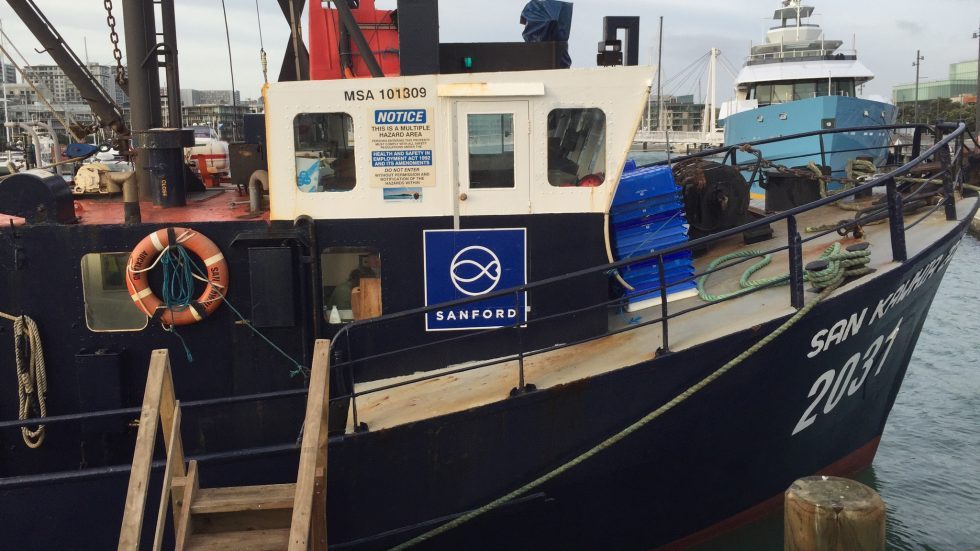A world-first innovative hydraulic safety function block has been successfully trialled in New Zealand, with the potential to improve machine safety across several industries

Safety engineering team TEG Risk has taken the helm in collaboration with Fluid Power Solutions to spearhead a pioneering safety solution for Sanford, a New Zealand-based fisheries operator.
Lead Engineer on the project Charles Webb designed a unique safety solution that not only ameliorates safety concerns for Sanford – but could also lead to greater safety outcomes for different fleets across Australasia.
The Challenge:
Sanford’s inshore vessels bring their catch directly to shore, while their six deepwater vessels process and freeze fish products at sea during expeditions that can last up to eight weeks. These operations take place in a high-demand, hostile environment where traditional safety measures often fall short. Traditional electrical components, including emergency stops, tend to fail within months due to exposure to UV radiation, rain, heavy seas, and seawater hosedown under pressure. The corrosive nature of high-salt seawater further complicated the safety design. Additionally, Sanford faced the challenge of minimising downtime, a significant factor across all their vessels, while ensuring the safety of their crew in this hazardous environment
Design Requirements for Maritime:
The maritime environment introduced unique design requirements, including reliability, ease of diagnosing undetected faults, minimising downtime, and ensuring compatibility with all machinery, despite low redundancy. The corrosive nature of seawater and frequent equipment hosedowns added to the challenges. Therefore traditional electrical emergency stops were replaced with a TEG Risk designed corrosion-resistant hydraulic manifold. The design also incorporated modular construction, series-connected inputs, a reset circuit for diagnostic coverage, expandable External Device Monitoring inputs, valve feedback, pressure feedback, and pilot pressure feedback to meet the specific maritime needs.
The Solution:
Off-the-shelf solutions were considered but were found unsuitable for the unique challenges presented by Sanford’s operations. Sanford’s requirement for a Performance Level ‘d’ safety solution, and operational within a hostile and corrosive environment, necessitated a ground-up design of a safety control system. To craft a solution the team at TEG Risk worked with Fluid Power Solutions, a leading engineering firm specialising in hydraulic systems and solutions. With Fluid Power Solutions and guided by data gathered from the risk assessment, an understanding of the environment, and Charles’ comprehensive engineering knowledge, a novel safety logic function was developed.
Hydraulic power emerged as the most suitable medium, given its extensive use for machinery aboard, reliability, and high immunity to seawater. Stainless steel was chosen for manifolds and piping on deck due to its high corrosion resistance, with aluminium used elsewhere. The function block consists of a modular system of hydraulic logic valves which connect the guards and emergency stops to the main hydraulic valve for the machine. If a guard is opened or emergency stop is pressed, the main hydraulic valve stops oil flow and de-energises the machine. There are also diagnostic functions to detect and react to valve failures, and indication of fault conditions. Standard cartridge valves are used which are highly reliable and field-serviceable; this means only the faulty valve needs to be re-kitted with new seals or replaced with local stock with minimal lead time. The final design was meticulously analysed with a Fail Mode Effects Analysis (FMEA) to locate and rectify any design defects.
The Result:
This groundbreaking design not only met the safety requirements but the modular design allows each and every application to be customised to suit. Re-kitting or replacing only the faulty components eliminates unnecessary waste, plus the entire system including valves are fully recyclable. The TEG Risk team is now looking into ways this unique solution could improve machine safety for all large or dedicated hydraulic systems across Australasia, including nautical, earthmoving, quarry, mining, and agricultural applications.





